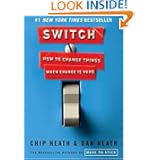 Switch: How to Change Things When Change is Hard is a great book that I'd really recommend. It clocks in at 11 chapters, 259 pages. Each chapter is broken into smaller sections that either introduce a concept or reinforce an idea through real-life examples. Also scattered throughout the book are "clinics" where a problem is laid out, and then you are challenged to apply what you've learned to the problem, followed by the answer - what really happened.
Switch: How to Change Things When Change is Hard is a great book that I'd really recommend. It clocks in at 11 chapters, 259 pages. Each chapter is broken into smaller sections that either introduce a concept or reinforce an idea through real-life examples. Also scattered throughout the book are "clinics" where a problem is laid out, and then you are challenged to apply what you've learned to the problem, followed by the answer - what really happened. I would really recommend this book to anyone who has anything in their work or personal lives they'd like to change, either within themselves or their environment or the people they interact with. The authors themselves make it clear that this isn't their brand new invention, highlighting a number of books in the "Recommendations for Additional Reading" at the end, explaining how each provides further example or insight into one of the principles they've covered.
But what makes this book unique and compelling is that they've packaged up the ideas into a simple, easy to use, easy to understand set of concepts that you can apply and see results with, even if you didn't read all the other books they recommend. So how is this new enough that I would praise it instead of accusing them of just stealing other people's ideas? It's the way it's packaged, made easy to relate to and brought together. The aggregation and synthesis is what makes it so compelling.
The book starts by asking you to think of the problem or situation as an elephant with a rider on a path. The rider is logical and thinking. But he's much smaller than the elephant and it takes a lot of work for him to control the elephant. And the path is the way to get from point a (current reality) to point b (the change you want to see). And the elephant is, well, the elephant - a large, emotional, less-intelligent creature -- and then points out that every situation will have these three elements. The book talks you through how to convince both the rider and the elephant that the journey must be taken and how to increase the likelihood that the journey will be taken by clearly identifying the right path and making sure it's clear of obstacles.
Nurses wearing construction vests have fewer prescription errors? Check. The size of the free popcorn you're given at a theater determines how much of a glutton you'll be? Check. Giving government employees credit cards will lead to tax savings on purchases? Check and check.
You will find this book difficult to put down and will finish it quickly. I think this is a book that I will want to re-read from time to time to re-inspire me and to help these concepts sink in even better.
No comments:
Post a Comment